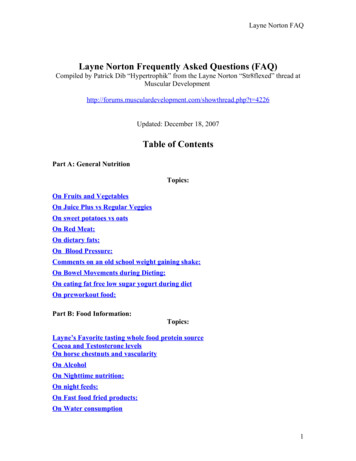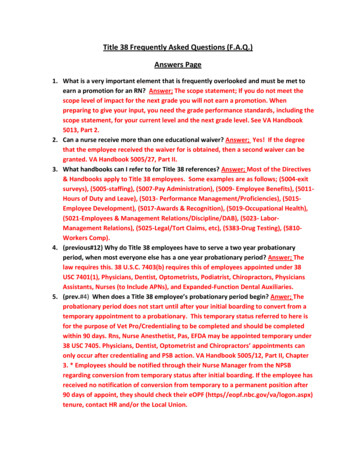
Transcription
Frequently asked questions aboutFrequently asked questions about product licensingproduct licensingGet answers to your product licensing questions. This page contains answers to the top productlicensing questions that our Microsoft support teams receive.The following questions are related to product licensing under Microsoft Volume Licensingagreements unless otherwise noted. Licensing information for retail (full packaged product) or originalequipment manufacturer (OEM) products can be found in the Software License Agreement terms forthose products. If you need more information or your question isn’t answered here, please contactyour Microsoft Reseller or your regional Microsoft customer support center.GeneralIntroduction to Product TermsWhat is the Product Terms document, and what happened to the Product List and Product UseRights (PUR)? My organization’s Volume Licensing agreement points to the Product List andPUR for how to license, deploy, and use products.The Product Terms replaced the Product List and Product Use Rights (PUR) beginning July 1, 2015.The Product Terms consolidates and distills the content previously published in the Product List andPUR, without substantively changing terms and conditions for existing products. We combined thetwo documents into one Product Terms document that’s structured based on the products so that it’seasier to understand how to purchase and use products. The new document reduces the overall sizeof the contract without diminishing customers’ use rights.My organization’s Volume Licensing agreement does not reference the Product Terms. Howcan the new document apply to how we license, deploy, and use products?The Product Terms is backward compatible with existing Volume Licensing agreements. The ProductTerms states that references to Product Use Rights and the Product List in customer agreements referto the applicable sections of the new document. The Product Terms doesn’t substantively change howyou may deploy and use products, and existing customers can look to the Product Terms (forproducts covered by the new document) or, as your agreements permit, the existing Product UseRights for your use of product versions that were available prior to July 1, 2015. For more information,download Microsoft Product Terms Explained.I like the idea of having everything in one place, but how do I use the Product Terms?The Product Terms is organized around Product Entries. The Product Entries provide informationspecific to a product and point you to other relevant content in supporting sections of the document(for example, Universal License Terms or the Software Assurance Appendix). Product Entries provideProgram Availability, Product Conditions, Use Rights, and Software Assurance terms. The document is1
Frequently asked questions about product licensingdesigned to be easy to use. For example, you can point to the blue text to display term definitions orclick links in the document to go to relevant terms and conditions outside of the Product Entries.How often will updates to the Product Terms be published?The Product Terms will be updated monthly. These monthly updates enable the use rights to bealigned with price list availability.My organization bought licenses for Microsoft Office Professional Plus in May. If we buy morelicenses in July, do we have to look at two different documents for terms governing differentusers’ use rights for the software depending on which licenses are assigned to them?The terms of your Volume Licensing agreement determine which license terms apply to the use ofsoftware. In some cases, the Product Terms in effect at signing an Enrollment governs use of allversions available as of that date and all licenses for those versions purchased during the Enrollment,regardless of the specific license order date. In other cases, the Product Terms in effect as of the orderdate governs use of software under licenses acquired.In which languages is the Product Terms available?The Product Terms is available for download in 35 languages.Downgrade rightsMy organization has a Volume Licensing agreement. Where can I confirm my specificdowngrade rights and eligible versions to downgrade?Downgrade rights (rights to use a prior version of a product) are granted as part of all the VolumeLicensing agreements. However, you need to refer to the Microsoft Product Terms for particulardowngrade paths for specific products because they may have migrated to other products or othereditions.For more information, see the Volume Licensing brief for downgrade rights.I have licensed Office Professional Plus 2013 through a Volume Licensing agreement. Can Idowngrade it to Office Standard 2013 or Office Standard 2010?No. Downgrade rights grant the end user the right to use prior versions of Microsoft software, notother editions of the software released at the same time, unless explicitly stated in the Product Terms(or successor documents).Note that Microsoft makes a distinction between the terms "version" and "edition" when referring toproduct licenses. The term "edition" means different functional offerings within a product family thatare usually released at the same time (for example, Office Professional Plus 2013 and Office Standard2013). The term "version" refers to different generations of a product family. Downgrade rightsbetween the current generation (N), the prior generation (N-1), and the generation prior to that (N-2)are limited to the same functional editions within each version (for example, Windows 10 Prodowngrades to Windows 8.1 Pro).2
Frequently asked questions about product licensingI need to downgrade to a prior version of a Microsoft product that my organization licensesthrough Volume Licensing. How do I get prior versions of products?Although you have the right to downgrade products, the Microsoft Volume Licensing Service Center(VLSC) generally provides download access only to the current (N) and the prior version (N-1) ofproducts. Note: In addition to VLSC download software access, all Volume Licensing customers canchoose to purchase physical media (CD/DVD) copies of their licensed software through theirMicrosoft Reseller.If you previously received physical media (CD/DVD) of prior Microsoft products that your organizationis currently licensed to use through downgrade rights, you may use these prior software versions atyour discretion. Learn more about Microsoft Volume Licensing fulfillment.Reimaging rightsCan I reimage OEM PCs with Volume Licensing Media?Yes, however some conditions apply. For more information, download the Volume Licensing brief forreimaging rights.Software AssuranceI purchased Office Professional Plus 2013 with Software Assurance, and my Software Assurancecoverage recently expired. How can I confirm which product version I’m entitled to upgrade tounder the Software Assurance New Version Rights benefit?To confirm when products were made available, review the Microsoft Product Terms.I purchased a product license with Software Assurance coverage almost three years ago, and Iwant to renew my Software Assurance coverage now. However, the product has beenrebranded and renamed since I first licensed it. Where can I find information about which newproduct version I should purchase with Software Assurance?To confirm successor versions of products and particular Software Assurance migration paths forproducts that have migrated to other products or other editions, review the Microsoft Product Terms.Refer to the index for products no longer available. The index will refer you to relevant migrationrights and the Product Terms (or Product List) update in which they appeared.Can I add Software Assurance to an OEM/Retail product license?Yes, you can attach standalone Software Assurance coverage to an OEM/Retail product license, butyou must do so within 90 days of purchasing the OEM/Retail (full packaged product) product license.This option is available only for particular products through particular Volume Licensing programs. Fordetails, see the Microsoft Product Terms.If I attach Software Assurance to an OEM/Retail product license within 90 days, which userights apply?If you acquire Software Assurance for an OEM/Retail (full packaged product) product license within 90days of purchase, you gain the option of installing and using the Volume Licensing software version3
Frequently asked questions about product licensingof the product at any time. If you do this, your use of the software becomes subject to the MicrosoftProduct Terms for that product and the terms and conditions of your organization's Volume Licensingagreement.Third-party useIn our company, we have onsite contractors who work on short-term projects. Can we assignMicrosoft product licenses (Office, CALs, etc.) that we purchased through our own VolumeLicensing agreement to these contractor-owned devices so that they use our licensed softwarefor our projects?Yes, as long as those licenses are used for the benefit of your company, the licensee, you can assignyour licenses to third-party devices.You’re limited in how often you can assign your licenses. Volume Licensing product licenses can bereassigned to other devices every 90 days, not more frequently. If the software will be used for thebenefit of the contractors and not your organization then the contractors need to purchase their ownlicenses or explore other types of short-term software subscription licenses.Windows client operating systemWindows 10Which versions of Windows 10 are offered through Volume Licensing?The following Windows 10 editions are offered through Volume Licensing: Windows 10 Enterprise E3 (available per user or per device)Windows 10 Enterprise E5 (available per user or per device)Windows 10 Pro UpgradeWindows 10 Enterprise LTSBWindows Virtual Desktop Access (VDA) (available per user or per device)Windows 10 Education E3/A3Windows 10 Education E5/A5See the Microsoft Product Terms for details by offer.Can I buy Windows 10 Enterprise offers outside of Volume Licensing?No. Windows 10 Enterprise offers are only available for purchase through Volume Licensingagreements.What is Windows Defender Advanced Threat Protection (WDATP)? Can my organization buyWDATP through Volume Licensing?Windows Defender Advanced Threat Protection is a service that helps enterprises detect, investigate,and respond to advanced attacks on their networks. It’s only available in Windows 10 Enterprise E5through Volume Licensing. Learn more about Windows Defender Advanced Threat Protection.4
Frequently asked questions about product licensingI can’t find Windows 10 Enterprise with Software Assurance or Windows 10 Education in theProduct Terms. Are these still available?Windows 10 Enterprise with Software Assurance is now Windows 10 Enterprise E3. And Windows 10Education is now Windows 10 Education E3/A3. These are simply name changes, with no change toincluded features.Upgrade LicenseWhat is a "Volume Licensing Upgrade License" for the Windows operating system for PCs?Microsoft Volume Licensing programs don’t offer Windows desktop operating system licenses;Volume Licensing provides only Windows upgrade licenses. Before you’re eligible to acquire anupgrade license for the Windows desktop PC operating system through Microsoft Volume Licensingprograms, you must first have licensed and installed a qualified full desktop operating system on yourdevice.Access by multiple users/devicesCan I use Windows Pro or Enterprise like a "server" to host applications?No. The Windows desktop operating system can’t be used as a "server." Device connection is allowedonly for certain purposes (such as File Services, Print Services, Internet Information Services, InternetConnection Sharing, and Telephony Services). If you want to host applications and access them frommultiple devices or for multiple users simultaneously, you need to license Server/CAL products. Formore information, download the Volume Licensing brief, Licensing Windows client and serveroperating systems in multiuser scenarios (PDF, 530 KB).Can I install multiple copies of the Windows operating system after I buy a Windows EnterpriseUpgrade license under my Volume Licensing agreement?You can install multiple copies of the Windows operating system on the licensed device only if thedevice licensed for Windows Enterprise is covered with active Software Assurance for Windows, asstated in the Microsoft Product Terms.I’m using a PC with Windows Enterprise that has four virtual machines (VMs) running on it. Canother users remotely access these VMs while I'm using my PC?No. The use of the software is limited to one user at any given time. This includes the use of RoamingRights (see below); while the primary user is accessing Roaming Rights, no other user is permitted touse the actual licensed device. For more information, see the Volume Licensing brief, LicensingWindows desktop operating system for use with virtual machines (PDF, 270 KB).Rental RightsMy company has rented PCs for its employees from a PC rental company. Should I purchaseRental Right licenses?No. Rental Rights licenses are special, supplemental licenses for purchase by PC rental or leasingcompanies that buy and continue to own fleets of PCs. They’re not designed for end-user customers.Learn more about Rental Rights.5
Frequently asked questions about product licensingWhen does my organization need Rental Rights licenses?Rental Rights licenses address scenarios in which organizations rent, lease, or outsource PCs to thirdparties. The following are examples of scenarios that are in and out of the scope of the Rental Rightslicenses.In scope Office equipment leasing companiesBusiness service centers (for example, copy/print stores)Internet cafésHotel and airport kiosksGovernment-tendered shared accessOut of scope License Microsoft products via a hosted solution (Services Provider License Agreement [SPLA])LibrariesAcademic institutionsInternal use (shared PCs)Traditional financing (for example, rent-to-own programs)Finance Leases and Long-Term Leases are permitted as described in the Lease Agreement forMicrosoft Products Installed on Leased Computers (PDF, 510 KB)Software Assurance and Windows Virtual Desktop Access (VDA)What editions of Windows are eligible for Software Assurance?Windows Enterprise is the only edition eligible for Software Assurance. Learn more about SoftwareAssurance.What is the Windows VDA (Virtual Desktop Access) subscription license?Windows VDA is a per device or per user subscription license designed to help organizations licensedevices or users that do not qualify for Software Assurance, such as "thin client" devices and userswho are not the primary user of a device that qualifies for Software Assurance. The license providesthe right to access a virtual desktop. Per device and per user Windows VDA subscriptions are availablethrough the Microsoft Volume Licensing Enterprise Agreement, Select Plus, Microsoft Products andServices Agreement, and Enrollment for Education Solutions programs. Per device Windows VDAsubscriptions are also available through the Open Value and Open Value Subscription programs.Can I license Windows Enterprise or Windows VDA on a per user basis?Yes. With Windows Enterprise per User and Windows VDA per User options, you license an individualinstead of a device. With the per user license, you can: Install Windows Enterprise locally on any of the licensed user’s devices that are licensed forWindows 7/8/8.1/10, and any Windows tablet that has a diagonal screen size of 10.1 inches orfewer.6
Frequently asked questions about product licensing Access Windows Enterprise across any of the licensed user’s devices with Virtual DesktopInfrastructure (VDI) or Windows To Go.Learn more about Windows Enterprise per User and Windows VDA per User.We have a Services Provider Licensing Agreement (SPLA). Can we provide Windows-baseddesktops as a hosted service for our end customers through SPLA?Currently, there’s no SPLA model for Windows VDA. Customers who subscribe to desktops from athird-party hoster will need to pay Microsoft for a Windows VDA license for each device accessingWindows client virtual machines in the datacenter. Additionally, hosters need to ensure that theyisolate the hardware and other resources for each company (that is, no two customers can share thesame set of resources, such as hardware, storage, and the like).Remote AccessDo I need a Windows VDA subscription license to access my work PC in the office (licensed torun Windows Pro) remotely from my home PC (licensed to run Windows Home)?No. No more than once every 90 days, you may designate a single user who physically uses thelicensed device as the licensed user. The licensed user may access the licensed device from anotherdevice using remote access technologies. Other users, at different times, may access the licenseddevice from another device using remote access technologies, but only on devices that are separatelylicensed to run the same or higher edition of this software.DesktopOffice 365 ProPlusOffice 365 ProPlus is offered as a software product and under subscription services. Aren’tthose the same product?No. The products both offer a great productivity experience, but they’re not the same product. Theproducts are two different ways to consume Microsoft Office—you can choose the offering that bestfits your needs.Office 365 ProPlus is a per user subscription service offering, not a desktop application softwareproduct. To use the software, you must have an active subscription. You can install and use thesoftware on up to five different devices while the subscription is active.Perpetual rights are typically available under a desktop application license. With this type of license,you have the right to use the software for as long as you want (as long as you comply with otherlicensing conditions); however, the license is assigned to a single device that may be used by differentusers (one at a time).7
Frequently asked questions about product licensingI have a personal laptop device that I like using at work for meetings. How should I license thisdevice if I want to use Office 365 ProPlus?If you’re licensed for Office 365 ProPlus, you may deploy and use Office on up to five devices,anywhere; they may be either company-managed or third-party devices. You may deploy one of fivepermitted copies on a personal laptop device and use it to work from anywhere, at home or at work.Our company has a mixed deployment of Office Professional Plus 2010 and Office ProfessionalPlus 2013 under a Select Plus agreement. May I use Office Professional Plus 2013 in place of myOffice 365 ProPlus license? Aren’t those the same product?No. Office 365 ProPlus is a per user subscription service, not a desktop application software product(like Office Professional Plus 2013). Therefore, you must deploy the user-authenticated softwareprovided to Office 365 users.Qualified deviceAccording to the Microsoft Product Terms, the right to install an additional copy on a portabledevice for use by the single primary user of the licensed device, termed the "portable deviceright," is available for Microsoft desktop applications. My company has more than 1,000 OfficeProfessional Plus licenses under an Enterprise Agreement. Do I have portable device rights toalso install Office on 1,000 portable computers?No. The "portable device right" isn’t relevant for Office Professional Plus licenses purchased as"company-wide" Enterprise Products under the terms of Enterprise Agreement, EnterpriseSubscription Agreement, Open Value Company-wide, Open Value Subscription, and Campus andSchool Agreements.For those programs, all devices—including portable computers that are used by or for the benefit ofan organization's users—need to be counted as Qualified Devices in order to purchase EnterpriseProducts (such as Windows Upgrade licenses, Office Professional Plus, Core CAL Suite/Enterprise CALSuite).For more information see your Volume License agreement and Microsoft Product Terms.Remote accessDo I need an additional Office license to be able to remotely access my work PC in my officefrom my home PC?If you’re the single primary user of that work PC in the office, you may remotely access that PC fromany device. But if you aren’t the primary user of that work PC, you’ll need an additional Office licenseon the device that you’re using.The Microsoft Product Terms says I can use desktop application software on a network device.What does this mean?Under the network use provision, you may run software on a network server that will be accessed andused by your licensed desktops by using Remote Desktop Services (or similar technology) and/or VDI(Virtual Desktop Infrastructure). To access applications such as Office on your network, you must also8
Frequently asked questions about product licensinglicense each remote accessing device even if Office software isn’t installed on the local device (forexample the local device is a "thin client").I have installed Microsoft Office on a network server for access using Windows RemoteDesktop Services. I have acquired Remote Desktop Services User Client Access Licenses (CALs)for each of my employees. I want my employees to be able to access Microsoft Office from anydesktop/thin client. What licenses do I need to properly license Microsoft Office within thisenvironment?Because Microsoft Office is licensed through a device-based licensing model only, each desktopdesktop/thin client that’s used to access Microsoft Office by using Remote Desktop Services musthave a separate Microsoft Office license dedicated to it. Licenses for Microsoft Office can’t be sharedacross desktops to support concurrent use. Furthermore, with the 2007 release, generally only licensesobtained through Volume Licensing can be deployed to a network server for remote access. The samerules apply to VDI scenarios. Each desktop/thin client that’s used to access Microsoft Office runningon virtual desktops on the server must have a separate Microsoft Office license dedicated to it. Formore information, download the Commercial Licensing brief, Licensing Windows Server RemoteDesktop Services and Microsoft desktop applications for use with RDS (PDF, 508 KB).Multiple copies on a licensed deviceI’m running four Virtual Machines (VMs) with Windows Enterprise on a PC that has activeSoftware Assurance coverage. May I install the Office suite in each of the four VMs by usingonly one Office Professional Plus 2010 license?Yes, you may install any number of copies and any prior version on the licensed device. SoftwareAssurance isn’t required for this use right for Office.ServersCAL requirementsI have Exchange Server 2013 and SQL Server 2012 running on Windows Server 2012 R2. Are allClient Access Licenses (CALs) licensed in the same way?No. CAL requirements differ among server products. The general rule is that you must acquire andassign a CAL to each device or user that accesses your server software. Beyond that, however, theremay be product-specific exceptions to that rule that affect a given product’s CAL requirement.With Exchange Server 2013, for example, CALs aren’t required unless the server access is directly orindirectly authenticated by using Active Directory. For Windows Server, a CAL is required for all usersor devices that are accessing the server. The CAL must be of the same version or later; however, forWindows Server 2012 R2, you can use a Windows Server 2012 CAL to access the server.For complete information about the different Microsoft CAL requirements, see the Microsoft ProductTerms.9
Frequently asked questions about product licensingDo additive CALs work with only specific editions of server software, such as Standard Editionor Enterprise Edition, or do they work with any edition?Generally, additive CALs can access any edition of server software. For example, Exchange Server 2010and Exchange Server 2013 are available in both a Standard Edition and Enterprise Edition. TheExchange Standard CAL and Exchange Enterprise CAL may be used with either edition of the serversoftware.For more information, download the Commercial Licensing brief, Base and Additive Client AccessLicenses (CALs): An explanation (PDF, 523 KB).Do additive Remote Desktop Services (RDS) CALs work with only a specific version of serversoftware, such as Windows Server 2012 or Windows Server 2012 R2, or do they work with anyversion?The CAL version must correspond to the server software version that it accesses. Older versions ofCALs can’t be used with the newer version of the server software, but newer version RDS CALs can beused with an older version of the server software as defined in the RDS and TS CAL InteroperabilityMatrix.The only exception to this rule is the R2 server releases; the older CALs sometimes work with thenewer R2 release of server software. For example, there are no new Windows Server 2012 R2 RDSCALs required, so the current requirement is that you need at least a Windows Server 2012 RDS CALto access RDS on Windows Server 2012 R2 servers.Company B is an affiliate (a term defined in Volume Licensing agreements) of Company A. Ihave CALs purchased by company A under a Select Agreement to access company A's servers.Can I also access servers purchased by company B (under an Open License) utilizing those CALs?Yes. Your company's CALs permit access to servers licensed by your company or its affiliates. Theydon’t permit access to any other entity's licensed servers.Do I need a Remote Desktop Services (RDS) CAL if I’m using a third-party technology (such asCitrix XenApp, Citrix XenDesktop, Ericom PowerTerm WebConnect, Quest Virtual Access Suite,GraphOn Go-Global) to do VDI on Windows Server?Yes. An RDS CAL is required for any technology that’s used to directly or indirectly interact with agraphical user interface of the server software. This includes (but isn’t limited to) using MicrosoftRemote Desktop Services or other third-party software that enables multiuser scenarios on WindowsServer.Do I need an RDS CAL if I’m not running a multiuser environment but use functionality inRemote Desktop Services; for example, Remote Desktop Services Gateway?Yes. An RDS CAL is required for the use of any functionality included in the Remote Desktop Servicesrole in Windows Server. For example, if you’re using RDS Gateway and/or Remote Desktop WebAccess to provide access to a Windows client operating system on an individual PC/virtual desktop,both an RDS CAL and a Windows Server CAL are required.10
Frequently asked questions about product licensingFor more information, download the Commercial Licensing brief, Licensing Windows Server RemoteDesktop Services and Microsoft desktop applications for use with RDS (PDF, 508 KB).If a user or device accesses a server running Windows Server but is authenticating via a thirdparty authentication application (non-Microsoft-based authentication), does the user or devicestill require a Windows Server CAL?Yes, if the user or device is authenticated or otherwise individually identified by a server runningWindows Server through any other means, the user or device must have a Windows Server CAL. Thespecific Windows Server CAL requirement is defined in the Microsoft Product Terms.MultiplexingI’m aware that "accessing or using the services or functionality of SQL Server or any of itscomponents (for example, Reporting Services)" always requires a SQL Server CAL. What abouta situation in which a user posts a report (a defined publication of information on a fixedschedule) and other users simply look at the report in an HTML file or on a website? Theycannot actively influence the content that is being displayed. If the information from thisreport in HTML format is being made visible to other users, do they need SQL Server CALs?Yes. If those processes by which the data is made accessible to users are all automated, SQL ServerCALs (or per Core licenses) are required because this use is considered a multiplexing scenario.Multiplexing doesn’t reduce the number of Microsoft licenses that are required. End users arerequired to have appropriate licenses, regardless of their direct or indirect connection to the product.Any user or device that accesses the server, files, data, or content provided by the server that’s madeavailable through an automated process requires a CAL.However, if someone manually uploads or sends an HTML file that was made by SQL Server to awebsite, then SQL CALs aren’t required. For more information, download the Volume Licensing brief,Multiplexing—Client Access License (CAL) requirements (PDF, 594 KB).EC versus SPLAI have external users (users who are not employees or onsite contractors) who will access ourservers. How do I choose between External Connector licenses or licensing these users throughthe Services Provider License Agreement (SPLA)?An External Connector (EC) license is an alternative to CALs for each server that external users willaccess. An EC license assigned to a server permits access by any number of external users, as long asthat access is for the benefit of the licensee and not the external user. If the usage doesn’t meet theseconditions, you need to choose SPLA because such access is considered Hosting.11
Frequently asked questions about product licensingMulti-tenantI’m an SPLA Hosting Provider. Can end-customer–owned licenses (such as SQL Server, ExchangeServer, or other server applications acquired through Microsoft Volume Licensing agreements)be relied on for licensing a guest user in my virtualized environment licensed under SPLA?Yes. If your end customer has active Software Assurance on a qualifying server application licensedproduct, your end customer may use their qualifying license to run the application in an SPLAvirtualized environment. The virtualized environment used by the end customer must be dedicated tothe customer’s sole use and may not be shared with any other
I purchased Office Professional Plus 2013 with Software Assurance, and my Software Assurance coverage recently expired. How can I confirm which product version I 'm. entitled to upgrade to under the Software Assurance New Version Rights benefit? To confirm when products were made available, review the Microsoft Product Terms.
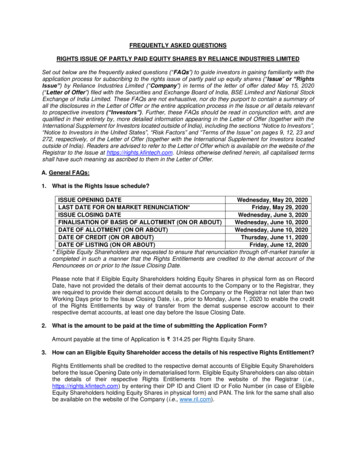
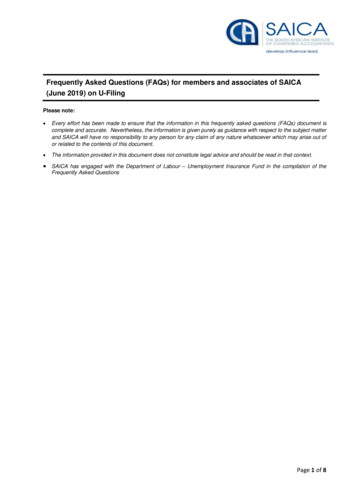
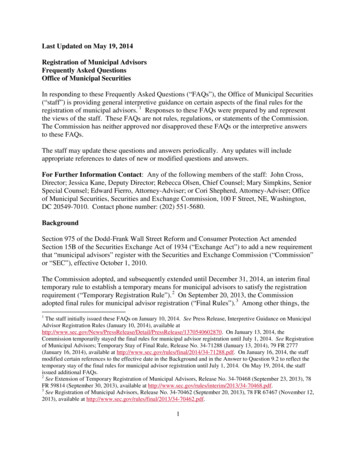
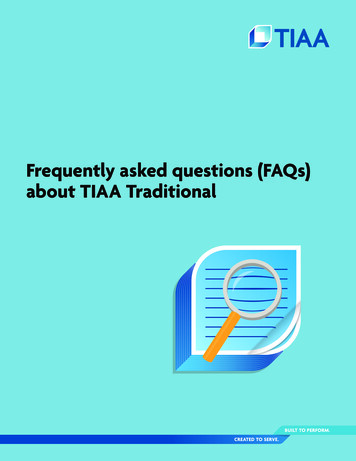
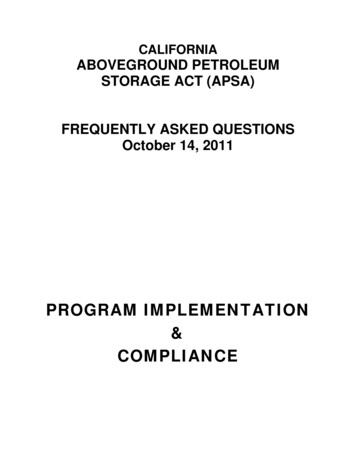
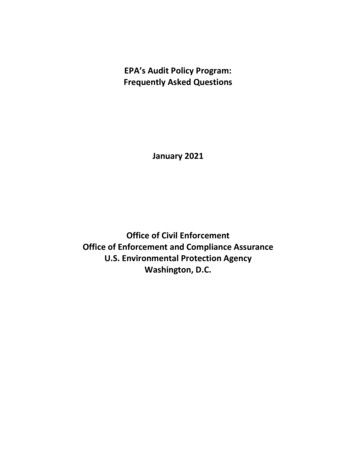
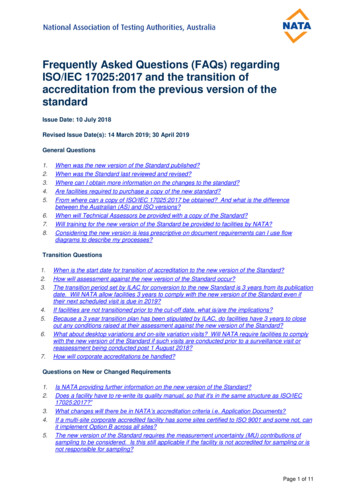
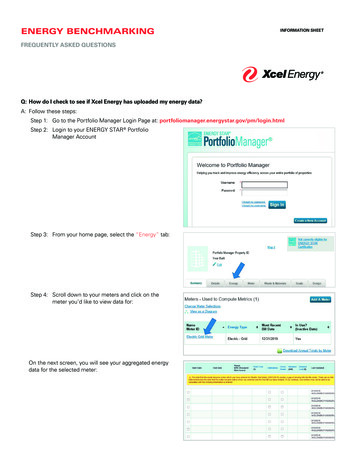
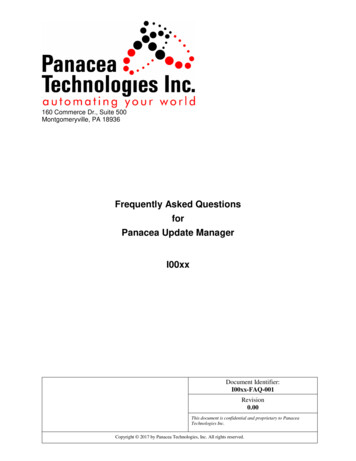
![Informatica Interview Questions and Answers [Scenario-Based]](/img/2/informatica-interview-questions-and-answers-scenario-based-1.jpg)
